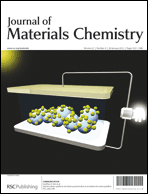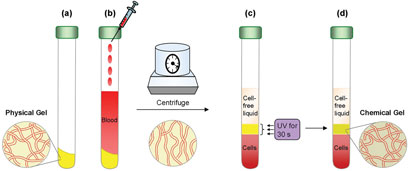This month sees the following Journal of Materials Chemistry articles in that are in the top ten most accessed for November:
Metal sulfide nanostructures: synthesis, properties and applications in energy conversion and storage
Chen-Ho Lai, Ming-Yen Lu and Lih-Juann Chen
J. Mater. Chem., 2012, 22, 19-30
DOI: 10.1039/C1JM13879K
Formation of mesoporous TiO2 with large surface areas, interconnectivity and hierarchical pores for dye-sensitized solar cells
Jung Tae Park, Joo Hwan Koh, Jin Ah Seo and Jong Hak Kim
J. Mater. Chem., 2011, 21, 17872-17880
DOI: 10.1039/C1JM10675A
Thiophene-based conjugated oligomers for organic solar cells
Fan Zhang, Dongqing Wu, Youyong Xu and Xinliang Feng
J. Mater. Chem., 2011, 21, 17590-17600
DOI: 10.1039/C1JM12801A
A facile chemical method to produce superparamagnetic graphene oxide – Fe3O4 hybrid composite and its application in the removal of dyes from aqueous solution
Guoqiang Xie, Pinxian Xi, Hongyan Liu, Fengjuan Chen, Liang Huang, Yanjun Shi, Fengping Hou, Zhengzhi Zeng, Changwei Shao and Jun Wang
J. Mater. Chem., 2012, 22, 1033-1039
DOI: 10.1039/C1JM13433G
Batteries based on fluoride shuttle
M. Anji Reddy and M. Fichtner
J. Mater. Chem., 2011, 21, 17059-17062
DOI: 10.1039/C1JM13535J
Synthesis of α-Fe2O3 nanorod/graphene oxide composites and their tribological properties
Hao-Jie Song, Xiao-Hua Jia, Na Li, Xiao-Fei Yang and Hua Tang
J. Mater. Chem., 2012, 22, 895-902
DOI: 10.1039/C1JM13740A
A review of advanced and practical lithium battery materials
Hao-Jie Song, Xiao-Hua Jia, Na Li, Xiao-Fei Yang and Hua Tang
J. Mater. Chem., 2012, 22, 895-902
DOI: 10.1039/C1JM13740A
Direct growth of monodisperse SnO2 nanorods on graphene as high capacity anode materials for lithium ion batteries
Chaohe Xu, Jing Sun and Lian Gao
J. Mater. Chem., 2012, 22, 975-979
DOI: 10.1039/C1JM14099J
Preparation of highly porous TiO2 nanotubes and their catalytic applications
Bingan Lu, Chengquan Zhu, Zhenxing Zhang, Wei Lan and Erqing Xie
J. Mater. Chem., 2012, Advance Article
DOI: 10.1039/C1JM15242D
Size control of Au@Cu2O octahedra for excellent photocatalytic performance
Lina Kong, Wei Chen, Dekun Ma, Yun Yang, Sensen Liu and Shaoming Huang
J. Mater. Chem., 2012, 22, 719-724
DOI: 10.1039/C1JM13672K
Why not take a look at the articles today and blog your thoughts and comments below.
Fancy submitting an article to Journal of Materials Chemistry? Then why not submit to us today!
Comments Off on Top Ten most-read Journal of Materials Chemistry articles in November














 Scientists at Tongji University, Shanghai, China, have developed a method of creating patterns on photonic paper that are only visible when the paper is wet. The siloxane-containing photonic paper is fabricated by using lithography to create a contrast of crosslinking or degree of hydrophobization. When the invisible prints are soaked in water for several minutes, the small difference in reflection wavelength (λ) between the pattern and the background is significantly amplified due to their different swelling speeds, which leads to a visible image. The process is fully reversible and soaking and drying will repeat the cycle of showing and hiding the patterns.
Scientists at Tongji University, Shanghai, China, have developed a method of creating patterns on photonic paper that are only visible when the paper is wet. The siloxane-containing photonic paper is fabricated by using lithography to create a contrast of crosslinking or degree of hydrophobization. When the invisible prints are soaked in water for several minutes, the small difference in reflection wavelength (λ) between the pattern and the background is significantly amplified due to their different swelling speeds, which leads to a visible image. The process is fully reversible and soaking and drying will repeat the cycle of showing and hiding the patterns.

 Combining metallic nanoparticles with host materials whose dielectric properties can be tuned by means of an external control is one route to create “active plasmonics”. In this hot article a soft-matter periodic structure made from a composite mixture of cholesteric liquid crystals and Au nanoparticles is reported. The cholesteric liquid crystals act as a “host fluid” whose refractive index can be varied in a broad range by using external electric fields and temperature variations. This has a strong influence on the position of the plasmonic absorption peak of the nanoparticles.
Combining metallic nanoparticles with host materials whose dielectric properties can be tuned by means of an external control is one route to create “active plasmonics”. In this hot article a soft-matter periodic structure made from a composite mixture of cholesteric liquid crystals and Au nanoparticles is reported. The cholesteric liquid crystals act as a “host fluid” whose refractive index can be varied in a broad range by using external electric fields and temperature variations. This has a strong influence on the position of the plasmonic absorption peak of the nanoparticles.

